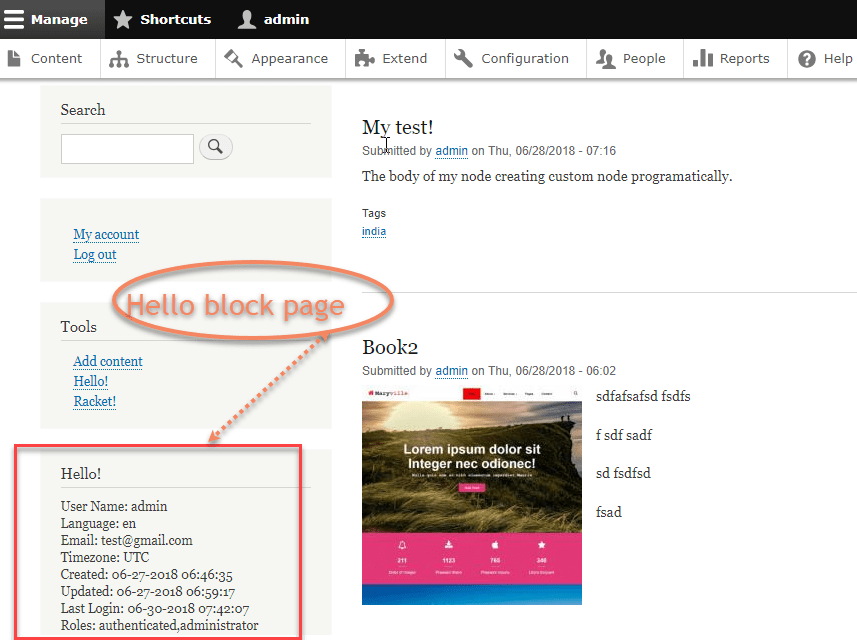Create custom blocks - Drupal 8 Example
Blocks can be displayed in regions (such as footer or sidebar) on your page.
Here we will expand the functionality of “hello module” to provide a block and create a block that displays the information about the current user logged in user.
Before starting this example, assuming you have read our previous example Create A Custom Module In Drupal 8.
In our example we will display some specific information about a user when user logged In.
(a) UserName
(b) Language
(c) E-mail Address
(d) Time zone
(e) Account Creation date
(f) Account Updation date
(g) Last logged in date
(h) User assigned role
In a case in which user is not logged in, it means this user is a anonymous user.
So it will simply display date and time.
To understand block directory firstly we will create” plugins directory ” under “src” directory.
Blocks are also known as Plugin in drupal 8 so here create a new directory named as “ Block ” in the ” plugin directory” inside you hello world module.
The structure is given below :
hello \ src \ Plugin \ Block

Within the “Block directory“, we will create a new file named as “HelloBlock.php” file.

In ” HelloBlock.php ” file, add the following code.
<?php
//include block directory
namespace Drupal\hello\Plugin\Block;
//include blockbase class
use Drupal\Core\Block\BlockBase;
/**
* Provides a user details block.
*
* @Block(
* id = "hello_block",
* admin_label = @Translation("Hello!")
* )
*/
class HelloBlock extends BlockBase {
/**
* {@inheritdoc}
*/
//generating the block output.
public function build() {
return array(
//t()used for print value
'#markup' => $this->t("Hello World!"),
);
}
}
?>

Upadated block plugin code is :
<?php
//include hello block.
namespace Drupal\hello\Plugin\Block;
// include user entity to get user related objects
use Drupal\user\Entity\User;
//include blockbase class.
use Drupal\Core\Block\BlockBase;
/**
* Provides a user details block.
*
* @Block(
* id = "hello_block",
* admin_label = @Translation("Hello!")
* )
*/
class HelloBlock extends BlockBase {
/**
* {@inheritdoc}
*/
//retuns the output generated by populate_markup function
public function build() {
return array(
'#markup' => $this->_populate_markup(),
);
}
private function _populate_markup() {
// Get current loged in user id and load user object
$user = User::load(\Drupal::currentUser()->id());
// if user id <1 then its a guest user
if ($user->get('uid')->value < 1) {
//displays output with t().
return t('Welcome Visitor! The current time is: ' . date('m-d-Y h:i:s', time()));
} else {
$user_information = 'User Name: ' . $user->getUsername() . "<br/>";
$user_information .= 'Language: ' . $user->getPreferredLangcode() . "<br/>";
$user_information .= 'Email: ' . $user->getEmail() . "<br/>";
$user_information .= 'Timezone: ' . $user->getTimeZone() . "<br/>";
$user_information .= 'Created: ' . date('m-d-Y h:i:s', $user->getCreatedTime()) . "<br/>";
$user_information .= 'Updated: ' . date('m-d-Y h:i:s', $user->getChangedTime()) . "<br/>";
$user_information .= 'Last Login: ' . date('m-d-Y h:i:s', $user->getLastLoginTime()) . "<br/>";
$roles = NULL;
foreach($user->getRoles() as $role) {
$roles .= $role . ",";
}
$roles = 'Roles: ' . rtrim($roles, ',');
$user_information .= $roles;
//returns user information.
return $user_information;
}
}
}
?>
see output in dashboard :

Here in the above code we have added a new function named as _populate_markup().
This function retrieves the current user information through the User :: load method.